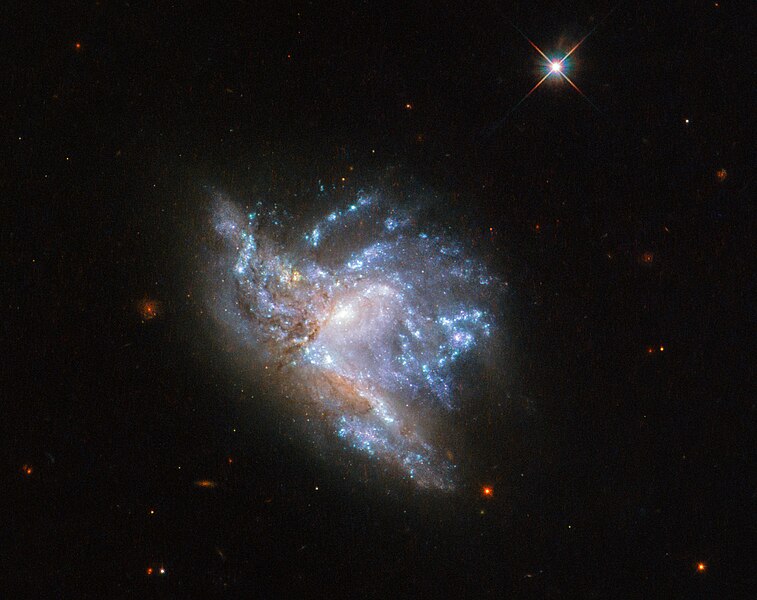File:NGC6052 - HST - Potw1909a.jpg

Original file (2,449 × 1,940 pixels, file size: 1.74 MB, MIME type: image/jpeg)
Captions
Captions
Summary edit
| DescriptionNGC6052 - HST - Potw1909a.jpg |
Colliding galaxies
A long time ago gravity drew the two galaxies together into the chaotic state we now observe. Stars from within both of the original galaxies now follow new trajectories caused by the new gravitational effects. However, actual collisions between stars themselves are very rare as stars are very small relative to the distances between them (most of a galaxy is empty space). Eventually things will settle down and one day the two galaxies will have fully merged to form a single, stable galaxy. Our own galaxy, the Milky Way, will undergo a similar collision in the future with our nearest galactic neighbour, the Andromeda Galaxy. Although this is not expected to happen for around 4 billion years so there is nothing to worry about just yet. This object was previously observed by Hubble with its old WFPC2 camera. That image was released in 2015. Credit: ESA/Hubble & NASA, A. Adamo et al. Coordinates Position (RA): 16 5 12.53 Position (Dec): 20° 32' 30.43" Field of view: 1.62 x 1.28 arcminutes Orientation: North is 45.0° left of vertical Colours & filters Band Wavelength Telescope Optical U 336 nm Hubble Space Telescope WFC3 Optical B 438 nm Hubble Space Telescope WFC3 Optical V 555 nm Hubble Space Telescope WFC3 Optical H-alpha 665 nm Hubble Space Telescope WFC3 Optical I 814 nm Hubble Space Telescope WFC3. |
|||
| Date | 4 March 2019, 06:00 (Release) | |||
| Source | https://www.spacetelescope.org/images/potw1909a/ https://cdn.spacetelescope.org/archives/images/large/potw1909a.jpg | |||
| Author | Credit: ESA/Hubble & NASA, A. Adamo et al. | |||
| Permission (Reusing this file) |
This file is licensed under the Creative Commons Attribution 4.0 International license. Attribution: ESA/Hubble
|
File history
Click on a date/time to view the file as it appeared at that time.
| Date/Time | Thumbnail | Dimensions | User | Comment | |
|---|---|---|---|---|---|
| current | 06:36, 4 March 2019 |  | 2,449 × 1,940 (1.74 MB) | Fabian RRRR (talk | contribs) | == {{int:filedesc}} == {{Information |Description='''Colliding galaxies Located in the constellation of Hercules, about 230 million light-years away, NGC 6052 is a pair of colliding galaxies. They were first discovered in 1784 by William Herschel and were originally classified as a single irregular galaxy because of their odd shape. However, we now know that NGC 6052 actually consists of two galaxies that are in the process of colliding. This particular image of NGC 6052 was taken using the... |
You cannot overwrite this file.
File usage on Commons
The following 5 pages use this file:
- Commons:WikiProject Aviation/recent uploads/2019 March 4
- File:Colliding galaxies.jpg (file redirect)
- File:Colliding galaxies (47316396381).jpg (file redirect)
- File:Colliding galaxies (50809915906).jpg (file redirect)
- Category:NGC 6052
File usage on other wikis
The following other wikis use this file:
- Usage on ar.wikipedia.org
- Usage on arz.wikipedia.org
- Usage on az.wikipedia.org
- Usage on ce.wikipedia.org
- Usage on de.wikipedia.org
- Usage on en.wikipedia.org
- Usage on mk.wikipedia.org
- Usage on nl.wikipedia.org
- Usage on pl.wikipedia.org
- Usage on ru.wikipedia.org
- Usage on sk.wikipedia.org
- Usage on tr.wikipedia.org
- Usage on tt.wikipedia.org
- Usage on www.wikidata.org
- Usage on zh.wikipedia.org
Metadata
This file contains additional information such as Exif metadata which may have been added by the digital camera, scanner, or software program used to create or digitize it. If the file has been modified from its original state, some details such as the timestamp may not fully reflect those of the original file. The timestamp is only as accurate as the clock in the camera, and it may be completely wrong.
| Image title |
|
|---|---|
| Credit/Provider | ESA/Hubble & NASA, A. Adamo et al. |
| Source | ESA/Hubble |
| Short title |
|
| Usage terms |
|
| Date and time of data generation | 06:00, 4 March 2019 |
| Software used | Adobe Photoshop CC (Windows) |
| File change date and time | 12:56, 25 September 2018 |
| Date and time of digitizing | 00:04, 26 September 2017 |
| Date metadata was last modified | 14:56, 25 September 2018 |
| Unique ID of original document | xmp.did:b89e5aa2-6252-3a43-997a-c6c0474d9cc8 |
| Keywords | NGC 6052 |
| Contact information |
Karl-Schwarzschild-Strasse 2 Garching bei München, None, D-85748 Germany |
| IIM version | 4 |

